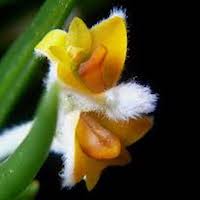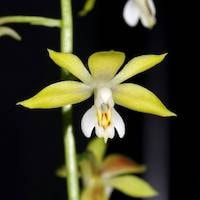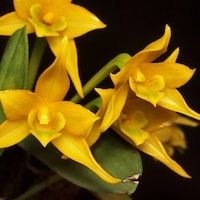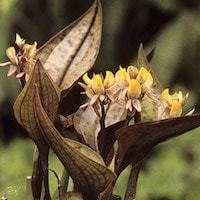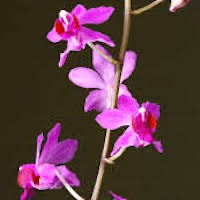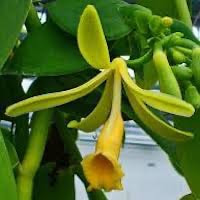Click for other Women's Oriental 1, Oriental 2, Oriental 3, Oriental 4, Oriental 5, Oriental 6, Oriental 7, Oriental 8, Oriental 9, Oriental 10, Oriental 11, Oriental 12
Contains Scented Notes of:
Turmeric- Sir Raffles Collection - Check details at Scentopia's scent library
Native Singaporean Orchid notes: Eria Pannea
|
Eria Pannea - Used in Oriental 5 (Women) for Team building Perfume workshop
Brilliant Vanilla smell but I personally do not like to flowers because of their white hair on the back side. But the oils is worth trying. With pleasure and respect, we would like to include a link to a tender document by URA. They have recommended adding this plant to the landscape as an effort to replant & to increase its population in Singapore. https://www.ura.gov.sg/sales/JRGTwnHall/MA/tenderdocs/JRGTwnHall-CA.pdf In Arunachal (India), this plant is one of the 34 grown for its medicinal properties. Malay, Indian, and Thai medicine also use this in medicinal bath to treat ague. Juices were extracted from plants and consumed, instilled to treat earache, or applied to snake and scorpion bites and boils. |
Therapeutic Orchid notes:
|
Calanthe graciliflora Hayata Syn. Calanthe hamata Hand. Mazz
Chinese names: Goujuxiaji Lan (splayed hooks prawn spine orchid), Xiyegenjie Lan (fine leaved, segmented root orchid), Xihuagenjie Lan (fine flowered, segmented root orchid), Zhihuagenjie Lan (brocade flower segmented root orchid), Goujuxiaji Lan(hooked prawn spine orchid) in Taiwan: slender flower Calanthe Chinese medicinal name: Silima Herbal Usage: In Taiwan, the entire plant is used to relieve fever and for detoxification. It boosts yin elements, benefits the lungs, improves blood flow, reduces stasis of blood, detumescence, and stops pain and coughing. On the mainland, the entire plant is used to treat rheumatism, bone pain, traumatic injuries. |
|
Liparis fargesii Finet
Chinese name: Xiaoyangersuan (small lip sheep ear garlic) Chinese medicinal name: Shimi It is found at 300–1700 m in Southern Gansu, Guizhou, Hubei, Hunan, Shaanxi, Sichuan and Yunnan. The plant is cold-resistant. Herbal Usage: Herb is obtained from Shanxi, Sichuan and Gansu. Entire plant is used in Chi- nese herbal medicine. It benefits the lungs, reduces heat, stops coughs, and is prescribed for tuberculosis, heat coughs and whooping cough. To prepare a decoction, 6–9 g of the dried herb is used at a time |
|
Nephelaphyllum pulchrum Blume
It has a creeping rhizome, fusiform pseudobulbs and heart-shaped leaves. It is widely distributed in India and Southeast Asia at 300–1000 m. In Peninsular Malaysia and Borneo, it is restricted to the mountains. Phytochemistry: A small amount of alkaloid (0.01–0.1 % dry weight) is present. Herbal Usage: It is used to treat injuries and also considered to be Diuretic |
|
Phalaenopsis pulcherrima (Lindl.) J.J.Sm. syn. Doritis pulcherrima Lindl.
Chinese name: Wuchun Lan Thai name: Ma wing Plant tends to develop numerous offshoots so that it soon becomes a community, and numerous roots are produced at the base. It is widely distributed in the lowlands throughout Myanmar, Thailand, Indochina, Hainan, northern Peninsular Malaysia and Sumatra. These are loved by the hybridizers in orchid flower industry. Phytochemistry: An alkaloid, Phalaenopsine 1A, has been isolated. Herbal Usage: Leaves are used to treat ear infections in Thailand. |
|
Vanilla planifolia Jacks. ex Andrews
Thai names: Wanila (in Bangkok), Vanilla It was introduced into cultivation in the French Reunion Island from Central America in 1817 by way of Mauritius because of the high content of vanillin in its large, fleshy seedpods which have a length of up to 15 cm. Today, vanilla comes from many sources which include Central America, Mauritius, Reunion, Madagascar, Indonesia, the Pacific Islands, India (northeast India, Kerala, Karnataka, Tamil Naidu and Lakshadweep), the Andaman and Nicobar Islands, Thailand, Indochina and China. In its native Central America, it grows in damp forests up to 600 m. They are hand-pollinated in the Vanilla farms. The exported products are the vanilla pods which are variable in quality and contents from source to source as well as from batch to batch. Fragrant Orchid: The major fragrance in vanilla pods is vanillin which accounts for about 2 % of the fermented fruit (range 1. 5–2.75 depending on provenance. However, vanillin is not present in newly harvested pods. It is formed during curing or fermentation when the precursor, non-volatile compound vanilloside (gluco-vanillin) undergoes beta-hydrolysis. Vanillin accounts for around 85 % of the volatile compounds. Another is p-hydroxybenzaldeyde (9 %), with p-hydroxybenzyl methyl ether accounting for 1 % Phytochemistry: About 130 compounds have been isolated from natural vanilla. These are made up of phenols, phenol ethers, alcohols, carbonyl compounds acids, esters, lactones, aliphatic and aromatic carbon hydrates and heterocyclic compounds. Herbal Usage: The whole plant is considered to have aphrodisiac value in India. The roots are used as a stimulant and to treat gonorrhea and dysuria, possibly resulting from the sexually transmitted disease. |
Other scent notes
Spices, lavender, animal musk, amber, white musks, Iso E super, Angelica, Cetalox, Labdanum, Cactus
